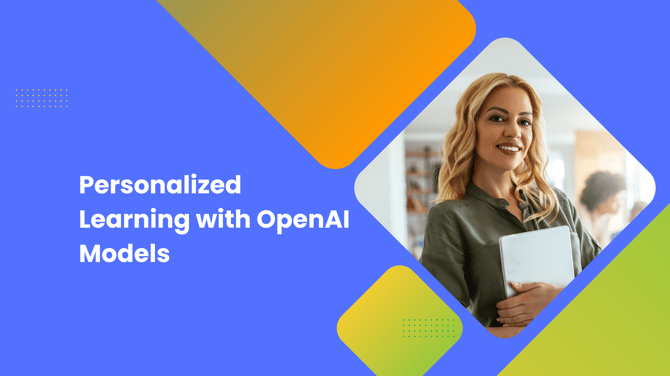AI Tutors and Personalized Learning with OpenAI Models
OpenAI models are transforming education with AI tutors that provide personalized learning, adapting to students' needs for more effective and accessible education.

Are you concerned about your child falling behind in class? Do you wish you had a tireless tutor who could provide individualized instruction 24/7? The traditional education system is struggling to keep pace with the diverse learning needs of students. But there's a ray of hope on the horizon: AI tutors.
Fueled by advancements in generative AI like OpenAI's GPT-3 models, AI tutors are intelligent software systems that leverage machine learning to provide personalized learning experiences. Imagine a world where your child receives tailored explanations, practices with adaptive exercises, and gets instant feedback – all facilitated by a tireless AI companion. Sounds like science fiction? It's not!
In this article, we will explore the concept of AI tutors and how they enhance personalized learning. We will also provide practical Python-based examples to illustrate their potential.
The Promise of AI Tutors
These intelligent tutors go beyond rote memorization. They adapt to a learner's strengths and weaknesses, offering dynamic explanations, exercises, and feedback that cater to their unique understanding. This personalized approach fosters deeper engagement and accelerates the learning process.
AI Personalized Learning Experience: Tailored Support for Every Learner
The magic of AI tutors lies in their ability to personalize the learning experience in several ways:
- Personalized Learning Paths: AI tutors create individualized learning pathways, ensuring students focus on the concepts they need to master.
- Adaptive Learning: The difficulty and type of content adjust based on the learner's progress, preventing frustration and promoting a sense of accomplishment.
- Real-time Feedback: Students receive immediate feedback on their work, allowing them to identify and rectify mistakes as they learn.
- Customized Study Plans: AI tutors can create personalized study plans, suggesting topics or exercises based on a learner's strengths and weaknesses. This ensures efficient use of study time.
Ready to Explore More About AI-powered Learning Solutions?
Embark on a journey with our AI-powered learning solutions to unlock a world where personalized learning paths pave the way for mastery at your own pace.
Building an AI Tutor: A Glimpse into the Future
Let's peek behind the curtain and see how an AI math tutor might be built using OpenAI's GPT-3 and Python. It's important to acknowledge that AI tutors are still under development, and their accuracy for highly complex problems may have limitations. Additionally, exploring alternative AI models beyond GPT-3 could unlock further possibilities for personalized learning across various subjects, such as:
- Natural Language Processing (NLP) Tutors: Imagine interactive language tutors offering personalized lessons, pronunciation guidance, and conversation practice in multiple languages.
- Intelligent Virtual Labs: Envision AI tutors in science and biology explaining complex concepts, providing virtual lab simulations, and assisting with real-world experiments.
- AI Coding Coaches: Aspiring programmers can benefit from AI tutors offering coding challenges, code review feedback, and debugging assistance.
Also read: 10 AI Tools That Are Similar To ChatGPT
Building an AI Tutor with OpenAI Models -
Here's a simplified example: using the math tutor
Here's a Python code snippet demonstrating the core concept.
|
|
Explanation:
- Import libraries: Import the
openailibrary to interact with the OpenAI API. - Set API key: Retrieve your OpenAI API key (assuming you have one) and set it as an environment variable.
solve_math_problemfunction:- Takes a math problem string as input.
- Constructs a clear prompt for GPT-3, including the problem and requesting a solution with explanation steps.
- Uses
openai.Completion.createto send the prompt to GPT-3, specifying the engine (e.g., "text-davinci-003"), maximum response length, number of responses, and temperature for controlling creativity. - Extracts the GPT-3 generated solution from the response object.
- Example usage:
- Defines a sample math problem.
- Calls
solve_math_problemto get the solution. - Prints both the problem and the generated solution.
Considerations and Best Practices for Responsible AI Development
As with any powerful technology, responsible Generative AI development and implementation are crucial. Here are some key considerations:
- Data Privacy: Protecting student data is paramount. Ensure the AI tutors you explore handle learner data securely and adhere to all privacy regulations.
- Ethical Use: Promote ethical AI practices. This includes responsible deployment of AI tutors and avoiding biases in educational content.
- Monitoring and Evaluation: Continuously monitor the effectiveness of AI tutors and gather user feedback to make improvements and ensure they are meeting the needs of learners.
- Accessibility: Design AI tutors to be accessible to a diverse range of learners, including those with disabilities.
- Human-AI Collaboration: Remember, AI tutors are powerful supplements, not replacements for human educators. Foster collaboration between AI and teachers to maximize the learning experience.
Conclusion
AI tutors powered by OpenAI models are revolutionizing education. They offer personalized, adaptive, and engaging learning experiences, making education more accessible and effective than ever before. As AI technology continues to evolve, the capabilities of AI tutors will only become more sophisticated, offering learners around the world the opportunity to unlock their full potential through a truly personalized learning journey.


%201-1.webp)


.png?width=344&height=101&name=Mask%20group%20(5).png)

















